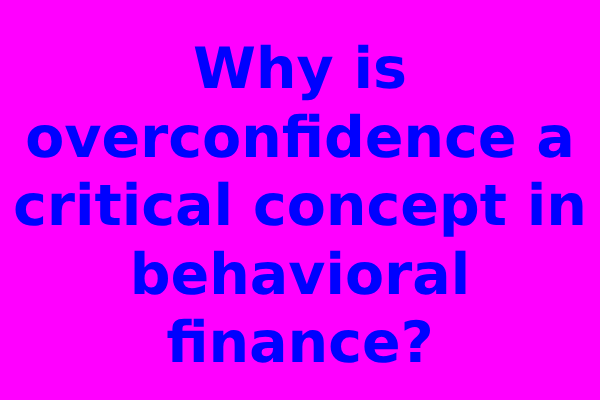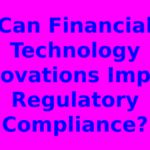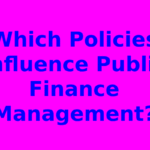Introduction:
In this article, I’ll delve into the intriguing realm of behavioral finance, focusing on a critical concept that has captured the attention of researchers and investors alike: overconfidence. While traditional financial theories assume rational decision-making, behavioral finance recognizes that human psychology often leads us astray in the world of investments.
Overconfidence stands at the forefront of these behavioral biases, representing a cognitive distortion where individuals tend to overestimate their own knowledge, abilities, and the accuracy of their predictions. This irrational self-assurance can have significant and far-reaching consequences in the world of finance, from stock market bubbles and bursts to suboptimal investment choices. By exploring the underlying mechanisms and real-world implications of overconfidence, we can gain valuable insights into the quirks of human behavior that shape financial markets and influence investment outcomes.
Because it impacts decision-making:
Overconfidence wields a profound influence on financial decision-making. When individuals exhibit excessive confidence in their abilities, they tend to make choices based on a heightened belief in the accuracy of their predictions and judgments. This can lead to a range of behavioral biases, including an unwarranted reliance on one’s judgment, an inclination to take on more risk, and a propensity to underestimate the potential for adverse outcomes. These biases manifest in various forms, such as investors overestimating their stock-picking prowess or underestimating the likelihood of a negative investment outcome. Consequently, overconfidence can result in suboptimal financial decisions, contributing to both gains and losses, with far-reaching implications for personal wealth and market stability.
In the context of decision-making, overconfidence often leads to overtrading and excessive portfolio turnover, as investors may be overly optimistic about their stock-picking abilities. This behavior can result in increased transaction costs and taxes, which erode returns over time. Moreover, overconfident decision-makers may not seek out diverse opinions or conduct thorough research, assuming their own judgments are superior. This lack of due diligence can result in a limited perspective, missing out on valuable information that could lead to better decisions. Overall, the impact of overconfidence on decision-making is significant, as it can create a turbulent investment landscape and hinder the achievement of optimal financial outcomes.
Because it leads to miscalculations:
Overconfidence often manifests in the form of overestimating one’s knowledge and underestimating uncertainty. These miscalculations can have detrimental effects on investment strategies and risk management. For instance, investors who are overconfident may incorrectly believe that they have superior insights into market trends or that they can accurately time the market. This can lead to trading decisions that are not based on sound analysis but rather on misplaced self-assurance, resulting in financial losses. Furthermore, overconfident individuals may neglect the complexity and unpredictability of financial markets, leading them to miscalculate risk and ignore the potential for adverse events.
One of the most significant miscalculations associated with overconfidence is the “illusion of control.” Overconfident investors tend to believe they have a greater degree of control over their investments and can predict market movements with precision. This illusion can lead to excessive trading, risky asset allocation, and an inability to adapt to changing market conditions. In reality, the financial markets are influenced by a multitude of unpredictable factors, making it impossible to exert absolute control. As a consequence, overconfidence-induced miscalculations can result in suboptimal investment outcomes and erode wealth over time.
Because it affects risk perception:
Overconfidence also has a profound impact on how individuals perceive and manage risk. Those who are overconfident often underestimate the level of risk associated with their investment decisions. This distortion in risk perception can lead to taking on more risk than is prudent and can result in substantial financial losses. When individuals believe they possess superior knowledge or abilities, they may be less inclined to diversify their portfolios or engage in risk-reducing strategies, such as hedging or stop-loss orders. This can expose them to greater volatility and the potential for significant drawdowns.
Furthermore, overconfidence can lead to a skewed perception of one’s ability to beat the market. Investors may underestimate the likelihood of making incorrect investment decisions, leading them to allocate more of their portfolio to high-risk, high-reward assets. This excessive risk-taking can result in a portfolio that is not adequately diversified, making it vulnerable to market downturns. Additionally, overconfident individuals may have a higher tolerance for risk because they believe they possess the skills to recover from any potential losses. In reality, this can lead to substantial financial setbacks, as risk-taking is often not commensurate with the actual abilities and knowledge of the investor. Thus, overconfidence’s impact on risk perception is a critical consideration in understanding its role in behavioral finance.
Because it drives trading behavior:
Overconfidence has a profound impact on trading behavior, often leading individuals to make impulsive and suboptimal decisions. Investors who are overconfident tend to engage in more frequent trading and exhibit a greater willingness to speculate on short-term price movements. This behavior can result in higher transaction costs and tax implications, which can erode overall returns. The overconfident trader is more likely to believe that their trading decisions are based on superior insights, and thus, they may not consider the long-term consequences of their actions.
One of the key drivers of overconfident trading behavior is the tendency to ignore sound investment principles and instead act on misplaced self-assurance. Investors may fail to diversify their portfolios adequately or may allocate a disproportionate amount of capital to high-risk assets. Such behavior can result in portfolios that are highly susceptible to market fluctuations and economic events. Additionally, overconfident traders may be more susceptible to herd behavior, as they believe their decisions are infallible, further contributing to market inefficiencies.
It is important to recognize that overconfident trading behavior can be particularly detrimental during times of market turbulence. Investors who are overconfident may hold on to losing positions for too long, hoping for a rebound, or they may engage in high-frequency trading to chase quick profits. These actions can lead to significant losses and volatility in the markets. Therefore, understanding how overconfidence influences trading behavior is essential for both individual investors and market regulators.
Because it influences portfolio choices:
Overconfidence significantly impacts the composition of investment portfolios. When investors are overconfident, they tend to favor individual stock-picking over diversified investments such as index funds. They believe that their ability to select outperforming stocks is superior to the market as a whole. This preference for individual stock selection can result in portfolios that are inadequately diversified and highly concentrated in a few assets.
Moreover, overconfidence can lead investors to ignore the benefits of risk management strategies. For instance, they may dismiss the importance of asset allocation, diversification, and rebalancing, as they believe their stock-picking skills will consistently outperform market averages. This overestimation of their own abilities can result in portfolios that are more volatile and exposed to individual stock risk.
Additionally, overconfident investors may have a propensity to engage in momentum investing, chasing recent market winners based on their belief in their predictive abilities. This can result in a portfolio that is driven by emotional responses rather than a well-thought-out investment strategy. Consequently, understanding how overconfidence influences portfolio choices is crucial for achieving a balanced and risk-optimized investment approach.
Because it’s linked to loss aversion:
Overconfidence and loss aversion often intertwine to create a complex psychological backdrop for financial decision-making. Loss aversion refers to the psychological bias where individuals feel the pain of losses more acutely than the pleasure of equivalent gains. When overconfidence and loss aversion combine, investors may be more prone to holding on to losing positions for extended periods, hoping for a turnaround.
Overconfident individuals often believe they possess the skills to recover from losses and may underestimate the risks associated with their investments. This overestimation of their abilities can lead them to take on excessive risk, which, when coupled with loss aversion, can result in a reluctance to cut their losses. As a result, they may hold on to losing investments longer than they should, in the belief that their judgment will ultimately prove correct.
This combination of overconfidence and loss aversion can lead to what is known as the “disposition effect,” where investors are more likely to sell winning investments to lock in gains but hold on to losing investments, often resulting in a portfolio with unrealized losses. This behavior can hinder portfolio performance and erode overall returns, making it essential to understand the interplay between overconfidence and loss aversion in the context of behavioral finance.
Because it fuels market bubbles:
Overconfidence plays a central role in the formation of market bubbles, which are periods of unsustainable price increases driven by investor enthusiasm and irrational exuberance. During a bubble, market participants become excessively optimistic about the future performance of certain assets, such as stocks or real estate, leading them to bid up prices to levels that are not supported by fundamentals.
Overconfident investors are more likely to believe that they possess superior insights and that their investment decisions will consistently outperform the market. This heightened self-assurance can fuel speculative behavior, contributing to the rapid escalation of asset prices. Overconfident individuals may disregard cautionary signals or critical analysis that suggests overvaluation, leading to a collective belief that the asset’s price will continue to rise indefinitely.
Market bubbles are often characterized by a feedback loop of overconfidence, as rising prices reinforce the belief in one’s investment prowess. This can attract more participants, further inflating the bubble. However, when reality eventually catches up and the bubble bursts, investors experience substantial losses. Thus, understanding how overconfidence can fuel market bubbles is essential for identifying and managing the inherent risks in financial markets.
Because it challenges market efficiency:
Overconfidence poses a significant challenge to the efficient market hypothesis (EMH), which asserts that financial markets incorporate all available information, making it impossible to consistently outperform the market. Overconfident investors believe that they have the skills and insights to beat the market, leading them to engage in active trading and stock-picking strategies.
This overconfident behavior contradicts the EMH, which suggests that attempting to outperform the market is futile. Overconfident traders may trade based on their unwarranted self-assurance, leading to a mispricing of assets. They may overreact to news or events, leading to excessive market volatility. Moreover, their speculative behavior can create inefficiencies in the market as they chase trends and rely on unfounded beliefs in their predictive abilities.
Over time, these challenges to market efficiency can lead to suboptimal investment outcomes for overconfident investors, as their strategies often underperform market averages after accounting for transaction costs and taxes. Consequently, the role of overconfidence in challenging market efficiency is a key focus within the field of behavioral finance, shedding light on the persistent debate regarding the degree to which financial markets are truly efficient.
Conclusion:
In conclusion, the exploration of overconfidence in behavioral finance underscores its pivotal role in shaping investment decisions and market dynamics. Overconfidence impacts decision-making, leading to miscalculations, influencing risk perception, and driving trading behavior. It significantly shapes portfolio choices, often exacerbating loss aversion. Moreover, it can contribute to the formation of market bubbles, challenging the efficiency of financial markets.
I hope this examination of overconfidence serves as a reminder that human psychology, replete with cognitive biases, is deeply intertwined with financial markets. Recognizing the pervasive influence of overconfidence offers investors the opportunity to employ more rational and disciplined strategies, promoting wiser investment choices. As we navigate the intricate world of finance, acknowledging the role of behavioral biases like overconfidence is a crucial step towards improving financial well-being and fostering a deeper understanding of the intricate tapestry that is the global financial landscape.


